In reply to Pete Gossett (Forum Supporter) :
I lol'd
So I referenced Reading #2101 in my brief stop and Steamtown and said "We don't talk about her", but I guess it is a story worth telling.
During WWII, the Reading realized that their mainstay steam motive power, I10-sa 2-8-0s and K1-sa/b 2-10-2s, were obsolete, with the shift from drag freight to fast freight. Their G3 Pacifics were also becoming overburdened by increasingly long and heavy passenger trains. Because the War Production Board was still in effect, diesels were hard to come by, being allotted primarily to lines that operated through drought-prone areas or mountains routes. And there was also restrictions on ordering brand new steam engines. So, Reading decided to take things into their own hands and ran 30 of their I10-sa Consolidations through the shops and rebuilt them into the T-1 4-84s.

With their big sloping Wooten fireboxes for burning anthracite coal, 27"x32" cylinders, 61.5" drivers and superheated boilers operating at 220psi, the I10-sa was a powerful engine, making 70,000lbs of tractive effort. But they were slow and their boilers could not supply steam for prolonged periods of time when being worked at their limits. The resulting homebrew Northern used the same boiler, but lengthened by over a foot and with the pressure bumped up to 240psi, a reused the original Wooten firebox (although the last fifteen received all-new fireboxes). Two-axle trailing trucks were installed on the front and rear with a booster engine in the trailing truck to help out at low speeds. New cylinders with the same dimensions as the I10-sa's turned 70" driving wheels. Small items like whistles, water gauges, headlights, air pumps, safety valves, and grate rigging were also reused. But the frame, cab, tender, side rods and many other major components were all new, and amenities like Worthington feedwater heaters and a mechanical stoker were added. Even so, the conversion came in at $157,000 per engine, which was a $75,000 savings over all new engines. The first twenty, #2100-#2119, were intended for freight use only and so had firction bearings on the rods and axles, while the final ten #2120-#2129, had roller bearings on the rods and axles for passenger usage, although they rarely handled passenger trains outside of WWII troop trains.
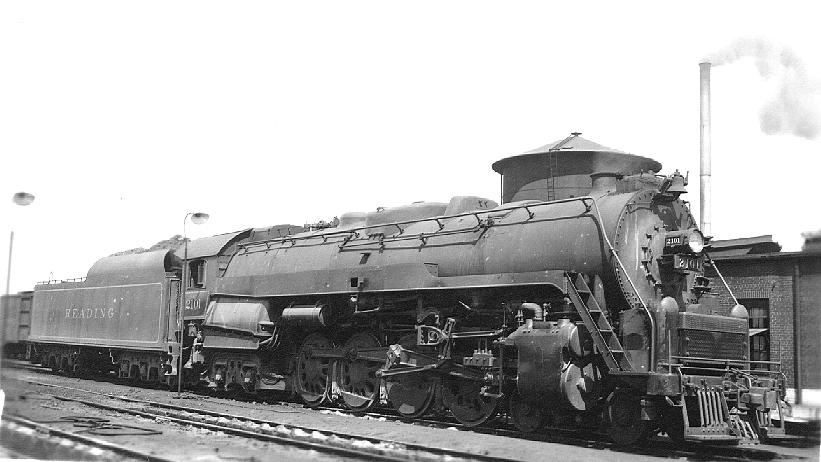
Reading #2101 was the second engine to be converted by Reading. Originally built in 1923 by Baldwin as #2021, it was rebuilt and renumbered in 1945. While only slightly less powerful than it's original configuration, it was a faster, more powerful engine, and along with her 29 sisters, became the Reading's primary motive power post-WWII. By all accounts #2101 lived a pretty average career, although there is a couple photos of it on its side, which indicates it had an accident at some point, although it was obviously repaired.

The T1s lead a relatively short life though. The Reading, in such close proximity to so many competitors in the overbuilt Northeast, began to dieslize in hopes of gaining an edge over the competition. The T1s were all retired from active service in 1954 and put in storage. A brief traffic surge in '55 pulled them out of temporary retirement, and 9 of them were also leased to the Pennsylvania Railroad (2107, 2111-2115, 2119, and 2128) but by 1957, with the arrival of Reading's order of Fairbanks-Morse H-24-66 Train Masters, they were all retired and scrapping began. But in 1959, Reading surprised everyone when they announced that they would begin a company-operated excursion program, called the Iron Horse Rambles. It's frequently said that Reading had 4 T-1s left at this point, #2100, #2101, #2102 and #2124, but there were actually five of them, counting #2123. #2123 was never operated on the trips though, and was instead used as a parts source for the other 4, being rarely seen. Although #2101 was operational, it was never used on the Rambles, instead held as reserve power, while #2100, #2102 and #2124 were the stars of the show. By 1964, the Reading's poor physical and financial health put an end to the Rambles. #2124 was sold off to Nelson Blount and went north to Steamtown USA, the remaining parts of #2123 lingered around the roundhouse in Reading until 1966 when the roundhouse was demolished and #2123 was scrapped, #2102 was sold to Steam Tours of Ohio in 1966 and #2100 and #2101 were sold to Streigel Equipment & Supply, a scrapyard in Baltimore, either in 1965 or 1967 (there's a discrepancy on that) where they sat for almost a decade.
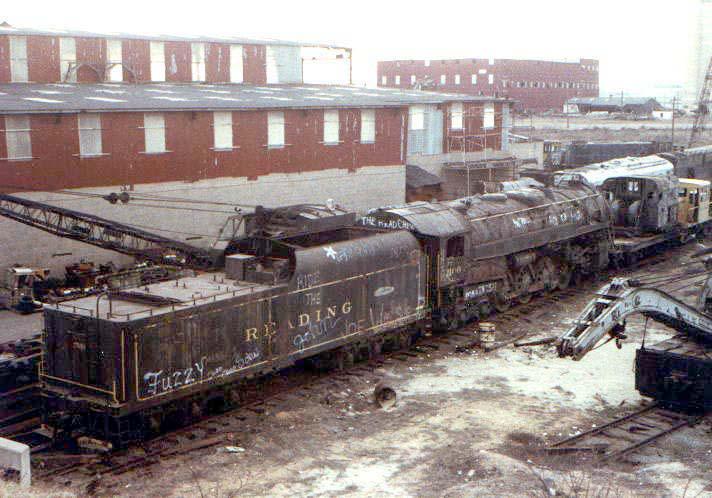
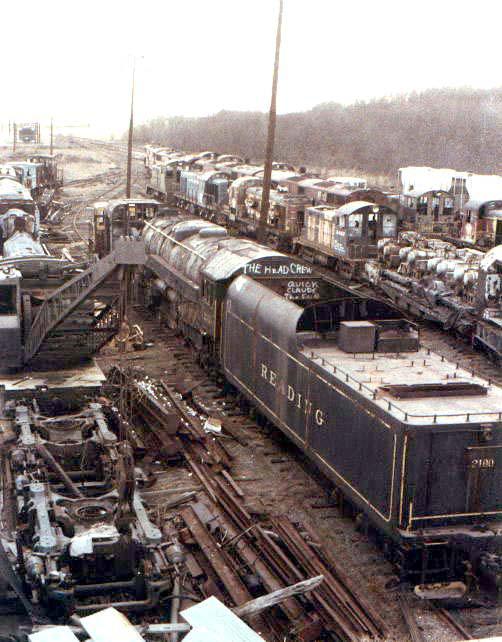
In 1975, planning was underway for the American Bicentennial and the American Freedom Train. Ross Rowland, who had run a conceptually-similar Golden Spike Limited for the Transcontinental Railroad Centennial, was brought in for the planning phase. Rowland wanted to use Nickel Plate #759, the Berkshire he had used for the Golden Spike Limited. It was modern, fast and powerful and had very few miles on it. Nickel Plate had overhauled it in '58, then placed it in storage for a traffic boom that had never materialized, Rowland had had it rebuilt in '68 and used it for the GSL, and then Steamtown USA, the owners, had used it very sparingly since. All it needed was repairs for some minor freeze damage that it had suffered during an aborted excursion in '73. Instead, he was overruled and the decision was made to fire up the last remaining Southern Pacific "Daylight" engine, SP 4-8-4 #4449. As the date got closer, someone realized that #4449 would not fit tunnels and station clearances on the eastern leg of the trip and Rowland was tasked with finding an engine to haul the eastern portion. So Rowland called up Streigel Equipment and purchased #2100 and #2101 from them. The decision was made to use #2101, since it hadn't been used for the Iron Horse Rambles and theoretically had less mileage and needed less work, and take parts from #2100 to get the #2101 operational. In just 30 days, Rowland and his crew turned #2101 from junkyard dog to shiny operational engine, complete with a slight makeover for use on the AFT and an old NYC Mohawk tender to use as an auxiliary tender.

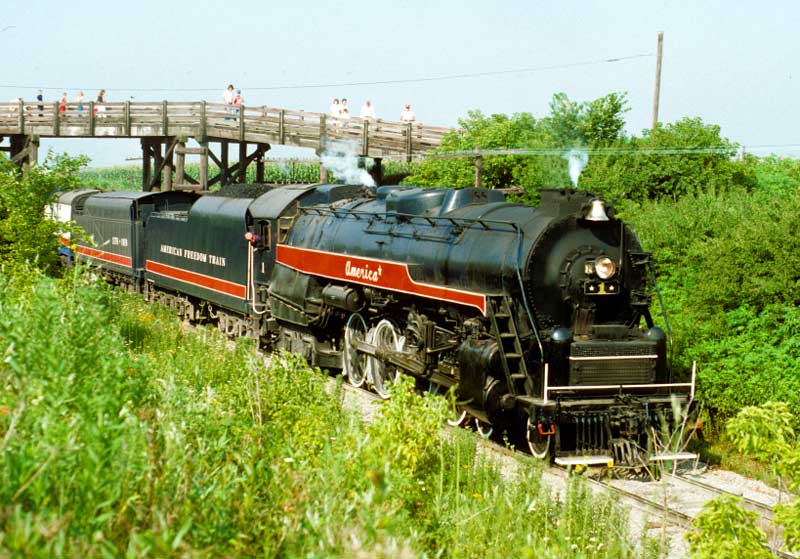
#2101 performed flawlessly on the AFT and afterwards, Rowland realized he had a nicely restored, operational Northern. Always the entrepeneur, he struck up conversation with Chessie Systems and they worked out a program to operate #2101 for Chessie System's (B&O's) 150th anniversary and then for general steam specials. #2101 again took on a new appearance, having it's headlight centered (improving its appearance) as well as a graphited smokebox, running board skirting and a snazzy Chessie Systems paint scheme.



After a successful 1977 season, it was given an extensive overhaul and returned for the 1978 Chessie Steam Special.
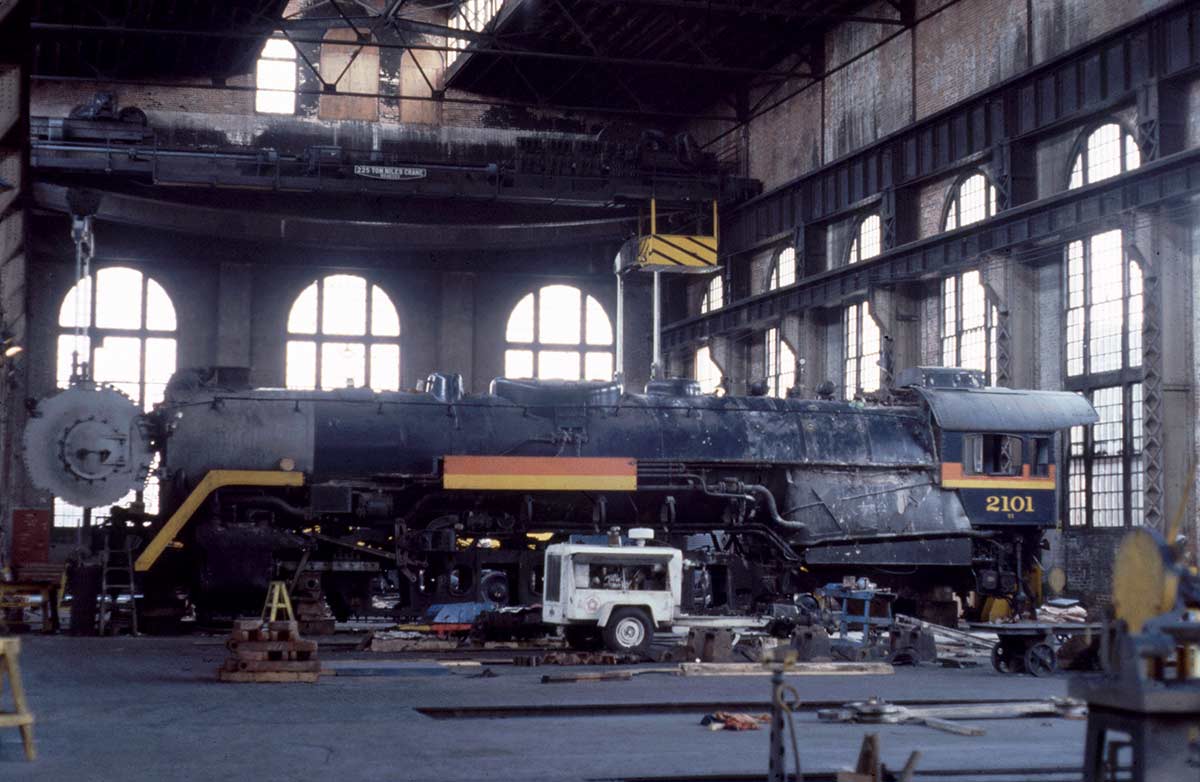

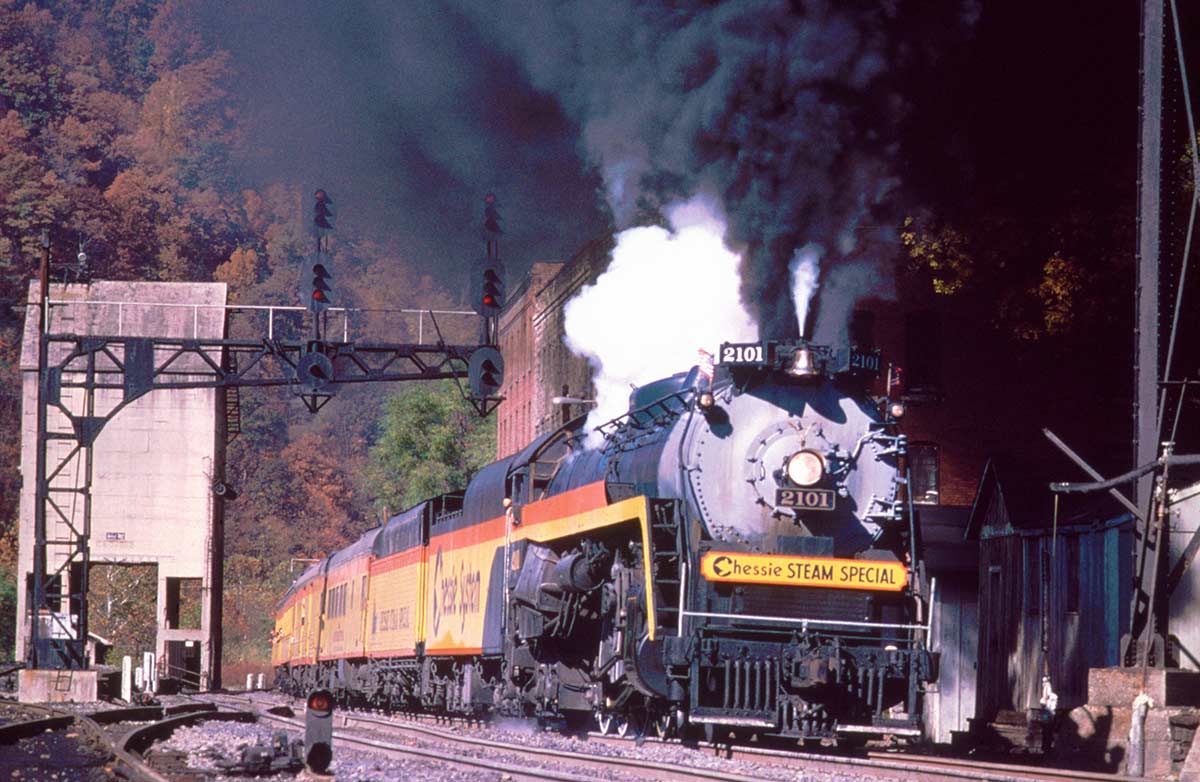
The agreement was renewed between Chessie and Rowland and #2101 was to return in 1979 as the Chessie Safety Special. But while stored at Chessie's Silver Grove roundhouse in the off-season, a fire broke out in the roundhouse. #2101 was damaged but still intact, but it left Rowland and Chessie with a situation to think on.
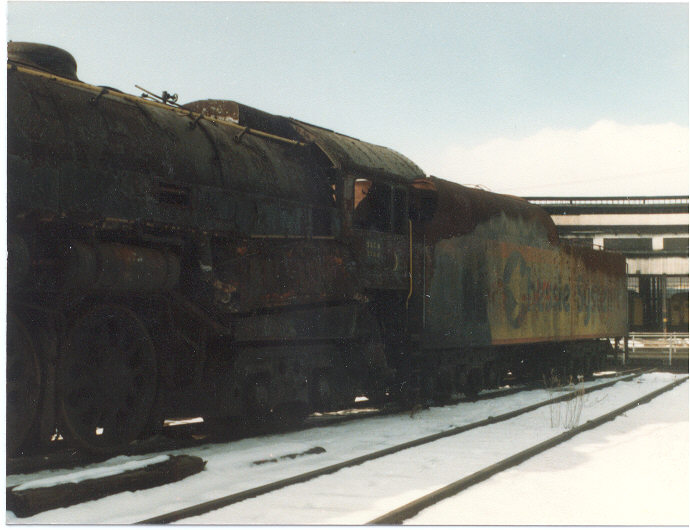
The consensus that Rowland and Chessie came to was that there was no way they could trust the #2101 to haul hundreds of passengers at mainline speeds. They had no idea what heat it had been exposed to and how it had affected the metallurgy. A frame crack or a broken drive wheel or connecting rod at 70mph, or a boiler failure, would all be disastrous. Rowling did own #2100 as well, but he really did not want to restore the engine as it had some of the same issues that he had had with #2101. For starters, being one of the original T-1s, they both had friction bearings, and while #2101 never had the issues of, say, Atlanta & West Point #290 or PRR #1361 (read, frequently stranded with hot journals) they had always been fiddly. Also, there was the fact that they were a Reading engine and Reading had become part of Conrail, which was a particularly sore spot for Chessie Systems, who had been putting money into the Reading and leasing equipment to them in the early '70s with hopes of acquiring the line, only for the ICC to instead snatch it away from them and roll it up into Conrail.
So with the search on for a modern, powerful, fast, roller-bearing equipped steam locomotive with B&O/C&O/Western Maryland ancestry, Rowland and Chessie Systems turned to the Baltimore & Ohio Railroad Museum and made a deal: they would trade them the #2101, cosmetically restored to it's American Freedom Train #1 appearance, and in return receive Chesapeake & Ohio #614, a 1948-built roller bearing-equipped, 72" drivered 4-8-4, called a Greenbrier by the C&O instead of a Northern.

So, #2101 got a restoration back to the AFT appearance, as well as a tender swap. Rowland decided to restore and operate #2100 for a different venture and found that even with fire damage, #2101's tender was in better shape than #2100's. With it painted back up, the trade was made and #2101 was entombed in the B&O Railroad Museum. These days, the poor T-1 looks pretty scruffty.

It seems unlikely that #2101 would ever see operation again. You would essentially have to build an entirely new locomotive with a new boiler and a new frame and new wheels (or at the very least, have them examined and inspected extremely thoroughly). At that point, it'd be easier and cheaper to convince Steamtown to relinquish #2124 and restore that (and not have to deal with friction bearings as well). But, sisters #2100 at American Steam Railroad in Ohio and #2102 at Reading & Northern in Pennsylvania are both rapidly approaching operational status.
Pete Gossett (Forum Supporter) said:In reply to NickD :
That Glen Campbell?
Different Glenn Campbell. I think.
The North American standard for motive power is, and has been for decades, diesel-electric; in other words, a diesel prime mover coupled to a generator which provides power to the traction motors that drive the wheels. That hasn't stopped railroads from experimenting, however. In 1961, one such experiment resulted in a rather notable locomotive making its way to the states from Europe. This was the Krauss-Maffei ML-4000. The ML-4000 is a six axle, Diesel-Hydraulic locomotive with a pair of turbocharged Maybach four-stroke V-16 diesels providing 3,540 hp to a Voith hydraulic transmission. The Denver and Rio Grande purchased 3 units, while the Southern Pacific had a total of 18 by 1965, including the three that the D&RGW bought. Both the SP and the D &RGW found the M-L unsuitable for mountain service on the steep grades of the western United States, but the SP found them quite satisfactory for service on the more level divisions of the railroad. By the late sixties, EMD and GE had taken note of the 3,000+ hp of the German diesels, and responded with new, higher horsepower six axle road units. By 1968, the SP had retired their ML-4000s and moved on to more conventional means of freight propulsion.

In reply to Recon1342 :
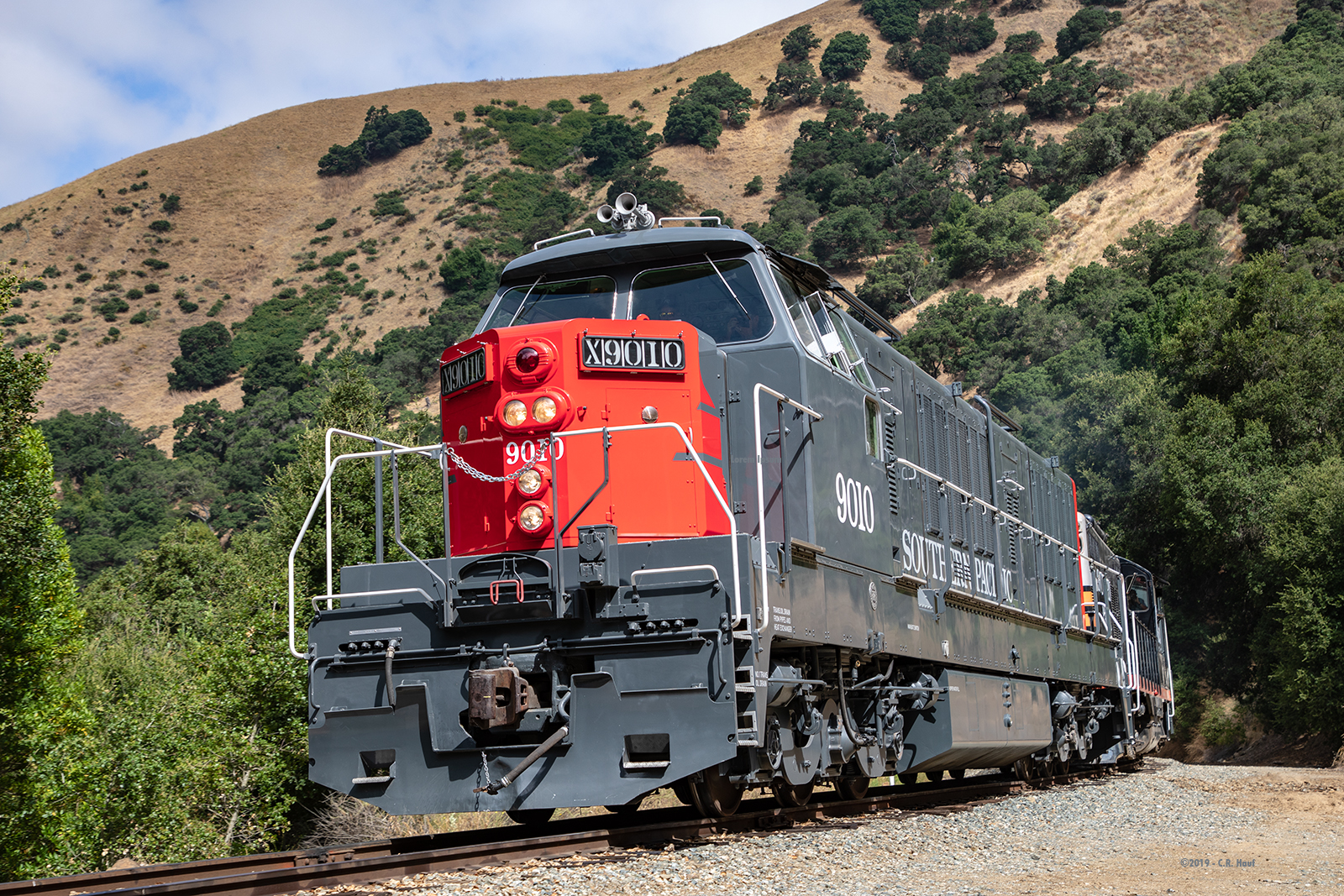 There is one of those now operational, #9010, at Niles Canyon Railway. #9010, renumbered to #9113 at the time, was parked when it suffered cylinder damage to the front Maybach V16. Espee cut the nose off the it, removed the front Voith transmission, gearboxes and driveshafts and installed cameras in the front of it. It was then pushed along the tracks to film for training simulators for engineers. When SP retired it from that duty in '84, they donated it to California State Railroad Museum, who then de-accessioned it and transferred it to Pacific Locomotive Association, who cut a deal with Niles Canyon to restore and operate it there. A new nose was built, the rear Maybach engine was overhauled, a truck with gearboxes was sourced from Europe and a new driveshaft was made. It is now operational at NCR. They have already said, there is no plan to return the front engine to operation, as it was severely damaged when retired and then has sat in the elements partially disassembled for years.
There is one of those now operational, #9010, at Niles Canyon Railway. #9010, renumbered to #9113 at the time, was parked when it suffered cylinder damage to the front Maybach V16. Espee cut the nose off the it, removed the front Voith transmission, gearboxes and driveshafts and installed cameras in the front of it. It was then pushed along the tracks to film for training simulators for engineers. When SP retired it from that duty in '84, they donated it to California State Railroad Museum, who then de-accessioned it and transferred it to Pacific Locomotive Association, who cut a deal with Niles Canyon to restore and operate it there. A new nose was built, the rear Maybach engine was overhauled, a truck with gearboxes was sourced from Europe and a new driveshaft was made. It is now operational at NCR. They have already said, there is no plan to return the front engine to operation, as it was severely damaged when retired and then has sat in the elements partially disassembled for years.
Alco also built 3 diesel-hydraulics for Southern Pacific, referred to as either a DH643 or a C643. It used a pair of 251 V16's making 2200 a piece, mounted nose to nose, with a pair of Voith transmissions. They were the second-longest Alco ever built (the Union Pacific C855s were bigger) and generated almost 100,000lbs of tractive effort, while being lighter than most of the other 6-axle Century diesel-electrics. But Alco tried using aluminum wire instead of copper wire and it was not up to the job, resulting in lots of electrical fires (the C855s had the same issue). And the Voith transmissions were just as troublesome here as in the Krauss-Maffeis, prone to locking up and stranding the locomotives, while being nightmarish to get parts for. Southern Pacific used them for less than a decade before cutting them up for scrap.

This was essentially the end of the diesel-hydraulic experiment in the US, another example of what works terrific in Europe is not necessarily a success in the US.
Denver & Rio Grande Western's KM-4000s had an interesting carbody that kind of looked like a mishmash between an EMD F-Unit and an Alco PA with an interesting turret cab

So, as I alluded to in my previous adventure, I made the decision to return to Jim Thorpe, PA to ride the Lehigh Gorge Scenic behind their steam engine, #425, a relatively lightweight (110 tons, compared to a USRA Light Pacific, which was 150 tons), low-drivered (69") Pacific that was originally built by Baldwin in 1928 for the Gulf, Mobile & Northern (1 of 2 for the the GM&N). Reading & Northern has operated the engine from 1983-1997 and then 1997-current, along the way making changes like a gorgeous dark blue paint scheme and graphited smokebox, a centered headlamp and roller bearings on the axles.
Since my father and I had basically had to cancel every event we had planned to attend this year (thanks, 'Rona) I bought two tickets for the open air cars, we hopped in the Yaris on Saturday morning at 7:15am and made the 3.5 hour drive down to Jim Thorpe (this would actually be my third visit to Jim Thorpe in a week, I'm sure their tourist board would be happy to know). Arriving at around 11, we got our tickets, walked around the town and then waited for #425 to show up, with boarding beginning at 12:30 and us wanting to be first in line. This is my video of it when it did arrive and was running back around to the front of the train.
I also snapped a photo of it and managed to catch the bell in mid-clang. The phone on my new camera is pretty darn impressive with it's clarity.

The reason I wanted to ride the open air car, is that you can lean out the window much easier. It's also coupled ride behind the locomotive on the trip up to Penn Haven, and that segment of the trip is all uphill, so you get to really hear the engine working. And for this weekend they also did not have any diesel assistance on the train, it was just the #425, 10 passenger cars and a caboose, so she was really working. This also means that you catch quite a few cinders, as I learned, which is not a phenomenon I had not experienced before. Every time I rode behind a steam engine (Strasburg and Steamtown), it was usually operating on flat ground and not being worked hard. But the boys at Reading & Northern do not spare the whip any, and this means you get a pretty good shower of cinders. I even caught one in my ear at one point. It felt like a bug flew into my ear, and as I reached up to get it out I realized it was hot. Fished a nice big coal cinder out instead.
The scenery was just as beautiful as the last trip. The Reading & Northern line is bits and pieces of both the CNJ and Lehigh Valley lines through the gorge and it twists and winds through the mountains and rock cuts and over the river and Norfolk Southern line on multiple bridges. You can see a couple waterfalls along the way, as well as armadas of rafts and kayaks on the river, and the right of way is littered with abandoned old brick buildings from the railroad heyday, as well as the remnants of railyards, an old Lehigh Coal & Navigation tunnel, and old telegraph poles and signal stands. Particularly interesting is the old oil pipeline (first in America, now a fiber optics cable line) that looks suspiciously like a mini suspension bridge and crosses the gorge 100 feet in the air. As our conductor (a really awesome guy named Tim Solomon) told us, there is a house at the end of it on the opposite side of the gorge, and they had two kids who would have to walk across the pipeline, climb down the embankment, flag a CNJ freight train and then ride it into Jim Thorpe to get to school.
A pretty cool gesture by our conductor was that when the train stopped at Penn Haven for the locomotive to uncouple and run around to the other end of the train he came up to me, kind of pulled me aside and said "I have to go help unload a couple bikes here. I'm going to accidentally leave the door to the vestibule unlatched, so you should go out there and make sure no one falls off." So, he unlatched the door to the vestibule, opened it a couple inches and then headed back to help unload the bikes and me and my father went out and stood on the vestibule and watched the locomotive uncouple, run forward and then switch back. When the conductor came back he went "Oh, I can't believe I left that door open. Everything okay up here?" Yep, everything's great.
After returning to Jim Thorpe, we then jumped in the Yaris and headed up to the CP Coal mileage marker, just past the Coalport bridge, which is really 3 bridges. One is an old wood-deck bridge that comes up from the Jim Thorpe branch, which wyes into a newer bridge from Reading, PA on the R&N main line, both over the Lehigh River. They then cross a 1907-era girder bridge that crosses the Norfolk Southern line. Just past that is a section where it runs parallel to the Lehigh Gorge State Park, and as we had learned, that was where the engineer really opened up the throttle. So, as soon as the train unloaded at Jim Thorpe, we hustled up there in the car, ate lunch and then picked out a spot to catch the train coming through on the 3:00pm train.
Now, I'd heard that R&N #425 is particularly loud for its size, and it was definitely noisy aboard the train, but I was unprepared for being trackside. The exhaust blast from this engine is very loud, at the point where it causes that painful reverberation in your ear when you are as close as we were. I've only encountered that level of sound before watching an unlimited class truck puller with a Top Alcohol motor. And then, they added that B&O 3-chime whistle on top, which is a great-sounding whistle, and which the engineer blew pretty frequently. What the #425 lacks in size in weight, she definitely makes up for in attitude.
After she went by, we decided to hang around and walk the trail and stretch our legs before heading home, and during that, we noticed that a bunch of people had cameras set up looking out over the mainline bridge over the Lehigh River. Asking a gentleman with a radio, we learned that a Reading & Northern freight train was coming up the mainline and was waiting for the 3:00 Lehigh Gorge train to clear. So we hung around a while, watched the 3:00 train head back down into Jim Thorpe and sure enough, 9000hp of SD40-2s came growling up the mainline with a mixed freight.

And with that, we hit the road. But we made one last detour to go check out the advertised "Free 100 Mile View."



Sadly this free view is soon to be spoiled by the Canyon Rim Estates built on this spot, as well as a winery. So, glad we visited before pricey estates make it inaccessible to the average viewer.
And with that, we hit the road back to NY, stopped by a diner for dinner, and got home at 10.
Also, of note, our conductor asked if we'd be back to see them running Reading #2102, and assured us "She's getting really close to being operational"
Video footage taken from the train by my father. That's me in the Track Dog Racing hat that keeps popping in and out of view. Also kind of sad that a 5 or 6 year old Sony digital video camera takes worse-quality video than an LG K51. Such is the march of technology. Also, at the beginning you'll hear my father saying "They're on the wrong side of the fence." Yeah, when we came over the Coalport Bridge, there was a bunch of teenagers on the inside of the fence, between the tracks and the fence. There was not much room there. I also saw people repeatedly skirting a crossing gate marked "No trespassing" to get better shots. That does not sit well with me. R&N doesn't have to run these trains, and when people do something like this and possibly get hit or injured it increases the odds of them cancelling them. People need to just behave themselves and deal with the fact that maybe the fence will be in their shot a little.
A video by a guy who is clearly more skilled than me and using much better equipment than me of the same weekend. Apparently the R&N crew swapped between a Southern long-bell 6-chime off a Ps4 Pacific and the B&O "tumor top" 3-chime over the weekend. I'm glad we caught it with the 3-chime, because that one sounds much better, although I still like the CNJ 3-chime that they also use occasionally the best. And as if 3 whistles weren't enough, apparently the R&N shop made their own unique whistle for it as well.
NickD said:Video footage taken from the train by my father. That's me in the Track Dog Racing hat that keeps popping in and out of view. Also kind of sad that a 5 or 6 year old Sony digital video camera takes worse-quality video than an LG K51. Such is the march of technology. Also, at the beginning you'll hear my father saying "They're on the wrong side of the fence." Yeah, when we came over the Coalport Bridge, there was a bunch of teenagers on the inside of the fence, between the tracks and the fence. There was not much room there. I also saw people repeatedly skirting a crossing gate marked "No trespassing" to get better shots. That does not sit well with me. R&N doesn't have to run these trains, and when people do something like this and possibly get hit or injured it increases the odds of them cancelling them. People need to just behave themselves and deal with the fact that maybe the fence will be in their shot a little.
That is why the telephoto lens was invented....
Reading & Northern has also purchased 2 of Norfolk Southern's 4 F-units, an F9PH A-unit and an F7B. These were NS's old executive units, and are F-units in appearance only (and even then there are some external changes, like those frenched-in ditch lights). Under the skin, they are essentially a GP38-2.

While the black, red and white scheme isn't bad, since their other diesels use the old Reading green and yellow, I was kind of hoping they would do them in Reading's black with green and yellow passenger scheme. The conductor asked if we had seen the F-units unit and said that they came out very nice.

The other cool piece of equipment that Reading & Northern owns is Reading T-1 #2102, one of the Reading's homebrew Northerns. After it was retired from the Reading's Iron Horse Rambles, it was sold to Steam Tours of Akron, Ohio they ran it for the next 20 or so years. Reading & Northern (at that time using the Reading, Blue Mountain & Northern name, which was later shortened) purchased it in 1985 and ran it alongside #425 until 1991, when the #2102's flue time expired. It has sat since then, although it was moved to Steamtown in 1995 for a restoration that never took place. In 1997 it was moved back to R&N's Port Clinton, PA shops and has sat mostly out of site since then. In 2016, Andy Muller Jr. announced they would be returning #2102 back to service and operation has progressed steadily. It was rumored to be returning this year, but steam locomotives are rarely done when they are supposed to be, and I'm sure the virus has screwed things up. But, our conductor Saturday did ask if we would be returning to see #2102 and informed us that she is "very close to operating."


There is a third, oft-forgotten steam locomotive owned by the Reading & Northern. Confusingly, it never operated under the Reading & Northern or Lehigh Gorge Scenic Railroad banners, despite being painted and numbered as an R&N engine and having pulled excursions out of Jim Thorpe. The engine, Reading & Northern #225, is actually Canadian Pacific #1098, a D-10 Class Ten-Wheeler built by Canadian Locomotive Company in 1913. Some time after CP retired the #1098, it was sold to Nelson Blount's Steamtown USA in Bellows Fall, VT, and then during one of the many sell-offs held by Steamtown USA/Steamtown NHS, it was sold to a gentleman named George Hart in the early 1970s. George Hart ran a company called Rail Tours Inc and was running excursions on the old Western Maryland Cumberland branch with a pair of CP Pacifics with the blessing of Allegany County. To go with #1098, he acquired another CP D-10, #972 (the second to last CP steam engine to be wiped from the books) from the Maryland & Pennsylvania and struck a deal with Jim Thorpe and Carbon County to run excursions up the consolidated Lehigh Valley/CNJ line.

#972 was developed a boiler leak in '86 and was sent to Strasburg for repairs that never happened, and around that time, Rail Tours Inc lost the charter for the Cumberland Valley operation, being replaced by the new Western Maryland Scenic. #1098 continued to operate on the Jim Thorpe line, running as late as 1994 (although what info I can find says she was used sparingly in 1994) and in 1995 Rail Tours Inc. lost Carbon County's charter to run out of Jim Thorpe, with recently-formed Reading, Blue Mountain & Northern getting the nod instead. As far as I can tell, RTI went bottom-up at this point and basically left their equipment at RBM&N's yard in Jim Thorpe (Strasburg inherited #972, which they had torn apart for repairs and then RTI had been unable to pay for). Supposedly in '95 or '96 RBM&N test-fired #1098 once, but since then it languished around the yard. RBM&N had #425 and #2102 already and #1098 was too small and too rough of condition. More recently they dragged the engine up to Port Clinton, painted it up similar to #425 and renumbered it as a cosmetic display, but have said there is essentially zero chance it will ever operate again. All accounts (and the condition of #972) say she was ridden hard and put away wet and has a number of conditions that the FRA frowns on and would require major work to rectify.

Still, a better fate than #972 at Strasburg, which was torn down, found to be needing basically every last nut, bolt, rivet, washer and cotter pin before RTI bailed on it. Strasburg then decided to cut off the firebox and make a shell to fit over the boiler to give it a faux Belpaire boiler and a PRR-style makeover in lieu of finding a PRR engine they could operate. They didn't get very far and the engine has since sat dismantled, originally as a "rainy day" project for the Strasburg shop's non-existent free time. The unofficial word from Strasburg is it needs far too much work and they have now signed a deal to operate a PRR/LIRR G-5 4-6-0 from the Long Island Railroad Museum once it is restored.

Note: the lack of solid details on the Rail Tours Inc. and their operations really hammers home the fact that info on those early '60s and '70s proto-tourist lines is harder to find than regular operations in the '30s-'50s. Somebody really needed to do a book on these about 20 years ago when a lot of the people were still around.
Canadian Pacific #972 leaving Jim Thorpe in her Rail Tours Inc. days. Its wearing the Cumberland Valley name from George Hart's other operation. I think that CNJ-painted RS3 is the one that Delaware-Lackawanna fixed up for Steamtown NHS a couple years back.

#972 at the old CNJ Mauch Chunk/Jim Thorpe station. A far cry from the Lehigh Gorge Scenic operations of today

At least #425 didn't hit a car while we were down there. About 3 years ago, while backing into Jim Thorpe, some genius in a Traverse either wasn't paying attention (and to not see or hear that engine, you have to be really not paying attention) or thought they could beat it across and got smacked. Did a number on the Traverse, just bent a foot ladder on the #425 and no one was hurt.
you've gotta be essentially dead to the world to not hear that on your doorstep. at that point its fair to question if that driver should just stick to taking the bus from there on out.
In reply to ScottyB :
They just got lucky that it hit the RF wheel house of the car and not further back. Especially because if the car was farther out, the coupler would have been the point of impact, which would have punched into the car, instead of just shoving it aside.
Good preservation news: Nevada Northern #81, one of the engine's original to when the Nevada Northern was an operating line and not a museum, had a fire in her firebox for the first time in 61 years this week. While not steamed up and under pressure, this was to hydro-test the boiler post-repair, so she's close.
Bad preservation news: The Swanton Pacific Railroad, a small tourist line that operated the very unique 19" gauge live-steam Pacifics from the 1915 Panama-Pacific International Exhibition, was essentially destroyed by the SCU Lightning Complex forest fire out in California. Most of the cars, buildings and 3 of the 5 steam locomotives (1 is on display at California State Railroad Museum, the other was in Cheyenne for boiler work) were severely fire-damaged or destroyed.

In reply to NickD :
I helped replace bearings in #81's side rods a year or so ago. Volunteered for a day while I was on vacation.
You'll need to log in to post.